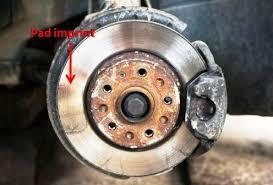Why Do Brake Rotors Warp?


Braking is one of the most critical functions of a vehicle, ensuring safety and control. However, many drivers experience issues with their braking system over time, one of the most common being warped brake rotors. This can lead to vibrations, reduced braking efficiency, and an overall uncomfortable driving experience. Understanding why rotors warp and how to prevent it can save you from costly repairs and improve the longevity of your brake pads and rotors. Let’s dive into the causes, symptoms, and solutions for warped brake rotors.
What Are Brake Rotors?
Brake rotors, also known as brake discs, are essential components of the braking system. They work alongside brake pads to create friction and slow down your vehicle. When you press the brake pedal, the brake pads clamp onto the rotors, generating heat and bringing the vehicle to a stop. Ideally, rotors should remain smooth and even, but certain conditions can cause them to warp, leading to braking problems.
Causes of Warped Brake Rotors
Several factors contribute to brake rotor warping. Here are the most common causes:
1. Excessive Heat Build-Up
One of the primary reasons for warped rotors is excessive heat. During braking, friction generates heat, and if the rotors cannot dissipate it effectively, they can become distorted. This is especially common in the following situations:
-
Frequent Hard Braking: Sudden stops or aggressive braking, especially at high speeds, generate significant heat, leading to warping over time.
-
Driving in Stop-and-Go Traffic: Constant braking in heavy traffic prevents rotors from cooling down properly, increasing the risk of warping.
-
Mountainous or Hilly Terrain: Driving downhill requires frequent braking, adding extra strain and heat to the rotors.
2. Uneven Torque on Lug Nuts
Improper installation of wheels can also cause brake rotors to warp. If lug nuts are not tightened evenly or over-torqued, they can create an uneven pressure on the rotor, leading to warping. This is why it’s essential to use a torque wrench and follow the manufacturer’s recommended torque specifications.
3. Poor Quality Brake Rotors
Not all rotors are created equal. Cheap or low-quality rotors are often made of subpar materials that are more susceptible to heat damage and warping. Investing in high-quality rotors can make a significant difference in durability and performance.
4. Worn-Out Brake Pads
Brake pads play a crucial role in maintaining rotor health. If brake pads are excessively worn, they can apply uneven pressure on the rotor, causing inconsistent heat distribution and leading to warping.
5. Overheated Brakes Due to Dragging Calipers
Brake calipers that don’t release properly can cause continuous contact between the pads and rotors, generating excessive heat. This prolonged heat exposure can warp the rotors over time.
6. Sudden Cooling of Hot Rotors
Exposing hot rotors to cold water or driving through a deep puddle immediately after heavy braking can cause rapid cooling and uneven contraction of the metal, leading to warping. This phenomenon is called “thermal shock.”
Signs of Warped Brake Rotors
How do you know if your brake rotors are warped? Look out for these common symptoms:
-
Steering Wheel Vibrations: If your steering wheel shakes when braking, it could be due to uneven rotor surfaces.
-
Pulsating Brake Pedal: A warped rotor causes inconsistent contact with brake pads, leading to a pulsating sensation when you apply the brakes.
-
Increased Stopping Distance: Warped rotors reduce braking efficiency, requiring more time and distance to come to a complete stop.
-
Unusual Noises: If you hear squeaking, grinding, or thumping sounds while braking, your rotors may be warped.
-
Uneven Brake Pad Wear: Warped rotors can cause brake pads to wear down unevenly, leading to premature replacement.
How to Prevent Brake Rotor Warping
Preventing warped rotors is possible with proper maintenance and driving habits. Here’s how:
1. Use Proper Braking Techniques
-
Avoid excessive hard braking whenever possible.
-
Instead of riding the brakes downhill, use engine braking by downshifting.
-
Keep a safe following distance to prevent sudden stops.
2. Ensure Even Lug Nut Tightening
-
Always tighten lug nuts in a star pattern using a torque wrench.
-
Follow the manufacturer’s torque specifications for your vehicle.
3. Invest in High-Quality Brake Rotors
-
Choose rotors from reputable brands with good heat dissipation properties.
-
If you drive aggressively or tow heavy loads, consider slotted or drilled rotors for better cooling.
4. Regular Brake Inspections and Maintenance
-
Have your brake system checked periodically by a professional.
-
Replace worn-out brake pads before they cause rotor damage.
-
Check for stuck calipers and have them repaired if necessary.
5. Allow Rotors to Cool Down Naturally
-
Avoid splashing water on hot rotors after intense braking.
-
After driving downhill, let the brakes cool naturally instead of coming to an abrupt stop.
Conclusion
Warped brake rotors can compromise your vehicle’s braking performance and safety. Understanding the causes, recognizing the signs, and taking preventive measures can help you avoid costly repairs and ensure smooth, reliable braking. Regular maintenance of your brake pads and rotors is key to keeping your vehicle’s braking system in top condition.
For professional brake inspections and rotor replacements, consider reaching out to a Mobile Mechanic from Instantcarfix. With on-site services, you can get expert brake maintenance at your convenience, ensuring a safer and smoother driving experience. Don’t let warped rotors compromise your safety—take action today!
- Art
- Causes
- Crafts
- Dance
- Drinks
- Film
- Fitness
- Food
- Games
- Gardening
- Health
- Home
- Literature
- Music
- Networking
- Other
- Party
- Religion
- Shopping
- Sports
- Theater
- Wellness


